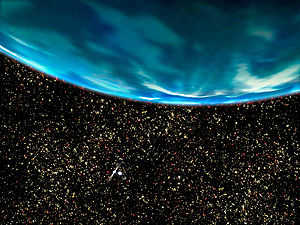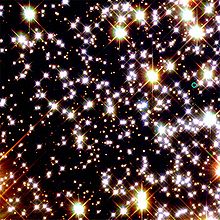- PSR B1620-26 b
-
PSR B1620-26 b Extrasolar planet List of extrasolar planets 
An artist's impression of PSR B1620-26 b
staring at its parent stars.Parent star Star PSR B1620-26 AB Constellation Scorpius Right ascension (α) 16h 23m 38s Declination (δ) -26° 31′ 53″ Apparent magnitude (mV) 24 Distance 12,400 ly
(3,800 pc)Spectral type Pulsar / DB Mass (m) 1.35 / 0.34 M☉ Age ? / 13 Gyr Orbital elements Semimajor axis (a) 23 AU Eccentricity (e) low Orbital period (P) 36,525 d
(~100 y)Inclination (i) 55° Physical characteristics Mass (m) 2.5 ± 1 MJ Discovery information Discovery date May 30, 1993
(confirmed July 10, 2003)Discoverer(s) Backer et al. Detection method Pulsar timing Discovery site  United States
United StatesDiscovery status Published Other designations Methuselah, PSR B1620-26 b, PSR J1623-2631 cDatabase references Extrasolar Planets
Encyclopaediadata SIMBAD data PSR B1620-26 b is an extrasolar planet located approximately 12,400 light-years away from Earth in the constellation of Scorpius (the Scorpion). It bears the unofficial nicknames "Methuselah" and "the Genesis planet" due to its extreme age and a few popular sources refer to this object as "PSR B1620-26 c" (see below for discussion). The planet is in a circumbinary orbit around the two stars of PSR B1620-26 (which comprises a pulsar (PSR B1620-26 A) and a white dwarf (WD B1620-26)). The planet is the oldest known extrasolar planet, believed to be about 12.7 billion years old.[1]
Contents
Name
While the designation PSR B1620-26 b is not used in any scientific papers, the planet is listed in the SIMBAD database as PSR B1620-26 b.[2] Some popular sources use the designation PSR B1620-26 c to refer to the planet,[3] presumably under the logic that since the A and B designations are used for the two stars it orbits, the planetary designations should start at "c". This usage is not supported in the scientific literature, nor does this designation appear in the SIMBAD database. As of November 2008, the only other known circumbinary planets orbit the eclipsing binary HW Virginis, however the discovery paper in that case also refrains from assigning designations to the planets, thus the matter remains unresolved.[4]
Though not officially recognized, the name "Methuselah" is commonly used for the planet in popular articles. The name comes from the biblical person Methuselah (who was the oldest living person).[5] This name is usually used as the informal name to show the similarities to the planets of the solar system, while the "latter name" is used astronomically. Methuselah is the only planet to have received a biblical name, although two additional extrasolar planets have been given mythological names (just like in the solar system), those planets being Bellerophon and Osiris. PSR B1620-26 b is one of the oldest planets in the universe, at approximately 12.7 billion years old. It has been under going many stages through its lifetime.
Detection and discovery
Like nearly all extrasolar planets discovered to date, PSR B1620-26 b was originally detected through the Doppler shifts its orbit induces on radiation from the star it orbits (in this case, changes in the apparent pulsation period of the pulsar). In the early 1990s, a group of astronomers led by Donald Backer were studying what they thought was a binary pulsar, determined that a third object was needed to explain the observed Doppler shifts. Within a few years, the gravitational effects of the planet on the orbit of the pulsar and white dwarf had been measured, giving an estimate of the mass of the third object that was too small for it to be a star. The conclusion that the third object was a planet was announced by Stephen Thorsett and his collaborators in 1993.
The study of the planetary orbit allowed the mass of the white dwarf star to be estimated as well, and theories of the formation of the planet suggested that the white dwarf should be young and hot. On July 10, 2003, the detection of the white dwarf and confirmation of its predicted properties were announced by a team led by Steinn Sigurdsson, using observations from the Hubble Space Telescope. It was at a NASA press briefing that the name Methuselah was introduced, capturing press attention around the world.[6][7]
Physical characteristics
PSR B1620-26 b orbits a pair of stars. One, the pulsar, is a neutron star spinning at 100 revolutions per second. The second is a white dwarf with a mass of 0.34 solar masses. These stars orbit each other at a distance of 1 AU about once every six months. As the first planet found in the system, the planet's designation is PSR B1620-26 b. The planet has a mass of 2.5 times that of Jupiter, and orbits at a distance of 23 AU (3,400 million km), a little larger than the distance between Uranus and the Sun. Each orbit of the planet takes about 100 years.[8]
The triple system is just outside the core of the globular cluster Messier 4. The age of the cluster has been estimated to be about 12.7 billion years, and because all stars in a cluster form at about the same time, and planets form together with their host stars, it is likely that PSR B1620-26 b is also about 12.7 billion years old. This is much older than any other known planet, and nearly three times as old as Earth.
Evolutionary history
The origin of this pulsar planet is still uncertain, but it probably did not form where it is found today. Because of the decreased gravitational force when the core of star collapses to a neutron star and ejects most of its mass in a supernova explosion, it is unlikely that a planet could remain in orbit after such an event. It is more likely that the planet formed in orbit around the star that has now evolved into the white dwarf, and that the star and planet were only later captured into orbit around the neutron star.[6][9]
 The evolution of the PSR B1620-26 system.
The evolution of the PSR B1620-26 system.
Stellar encounters are not very common in the disk of the Milky Way, where the Sun lives, but in the dense core of globular clusters they occur frequently. At some point during the 10 billion years, the neutron star is thought to have encountered and captured the host star of the planet into a tight orbit, probably losing a previous companion star in the process. About half a billion years ago, the newly captured star began to expand into a red giant (see stellar evolution).
Typical pulsar periods for young pulsars are of the order of one second, and they increase with time; the very short periods exhibited by so-called millisecond pulsars are due to the transfer of material from a binary companion. The pulse period of PSR B1620-26 is a few milliseconds, providing strong evidence for matter transfer. It is believed that as the pulsar's red giant companion expanded, it filled and then exceeded its Roche lobe, so that its surface layers started being transferred onto the neutron star.
The infalling matter produced complex and spectacular effects. The infalling matter 'spun up' the neutron star, due to the transfer of angular momentum, and for a few hundred million years, the stars formed a low-mass X-ray binary, as the infalling matter was heated to temperatures high enough to glow in X-rays.
Mass transfer came to an end when the surface layers of the mass-losing star were depleted, and the core slowly shrunk to a white dwarf. Now the stars peacefully orbit around each other. The long-term prospects for PSR B1620-26 b are poor, though. The triple system, which is much more massive than a typical isolated star in M4, is slowly drifting down into the core of the cluster, where the density of stars is very high. In a billion years or so, the triple will probably have another close encounter with a nearby star. The most common outcome of such encounters is that the lightest companion is ejected from the multiple star system. If this happens, PSR B1620-26 b will most likely be ejected completely from M4, and will spend the rest of its existence wandering alone in interstellar space as an interstellar planet.
See also
- 51 Pegasi b
- Pulsar planet
- PSR 1257+12
References
- ^ Britt, Robert Roy. "Primeval Planet: Oldest Known World Conjures Prospect of Ancient Life". Space.com. http://www.space.com/scienceastronomy/oldest_planet_030710-1.html. Retrieved 2007-06-12.
- ^ "NAME PSR B1620-26 b -- Extra-solar Planet Candidate". SIMBAD. CDS. http://simbad.u-strasbg.fr/simbad/sim-id?protocol=html&Ident=PSR+B1620-26+b. Retrieved 2008-09-01.
- ^ John Whatmough (2003). ""Methuselah" - PSR B1620-26 c". Extrasolar Visions. http://www.extrasolar.net/planettour.asp?StarCatID=pulsar&PlanetID=30. Retrieved 2008-09-01.
- ^ Lee, J.W. et al. (2008). "The sdB+M Eclipsing System HW Virginis and its Circumbinary Planets". arXiv:0811.3807v1 [astro-ph].
- ^ Gary Denke (2003). "Planet 'Methuselah' Discovered!". http://www.scienceagogo.com/message_board5/messages/399.shtml. Retrieved 2008-09-01.
- ^ a b Sigurdsson, S.; Richer, H.B.; Hansen, B.M.; Stairs I.H.; Thorsett, S.E. (2003). "A Young White Dwarf Companion to Pulsar B1620-26: Evidence for Early Planet Formation". Science 301 (5630): 193–196. arXiv:astro-ph/0307339. Bibcode 2003Sci...301..193S. doi:10.1126/science.1086326. PMID 12855802.
- ^ "Oldest Known Planet Identified". HubbleSite. http://hubblesite.org/newscenter/newsdesk/archive/releases/2003/19/. Retrieved 2006-05-07.
- ^ "Notes for star PSR B1620-26". The Extrasolar Planets Encyclopaedia. http://exoplanet.eu/star.php?st=PSR+B1620-26. Retrieved 2006-05-07.
- ^ Ford et al.; Joshi, Kriten J.; Rasio, Frederic A.; Zbarsky, Boris (2000). "Theoretical Implications of the PSR B1620-26 Triple System and its Planet". The Astrophysical Journal 528 (1): 336–350. arXiv:astro-ph/9905347. Bibcode 2000ApJ...528..336F. doi:10.1086/308167. http://www.iop.org/EJ/article/0004-637X/528/1/336/40658.html. (preprint)
External links
- Britt, Robert Roy (2003-07-10). "Primeval Planet: Oldest Known World Conjures Prospect of Ancient Life". SPACE.com. http://www.space.com/scienceastronomy/oldest_planet_030710-1.html. Retrieved 2008-06-20.
- ""Methuselah" - PSR B1620-26 c". Extrasolar Visions. http://www.extrasolar.net/planettour.asp?StarCatId=pulsar&PlanetId=30. Retrieved 2008-06-20.
- "Oldest Known Planet Identified". NASA. HubbleSite. 2003-07-10. http://hubblesite.org/newscenter/newsdesk/archive/releases/2003/19/. Retrieved 2008-06-20.
Categories:- Exoplanets discovered in 1993
- Extrasolar planets
- Gas giant planets
- Pulsar planets
- Scorpius constellation
- Exoplanets detected by timing
Wikimedia Foundation. 2010.


